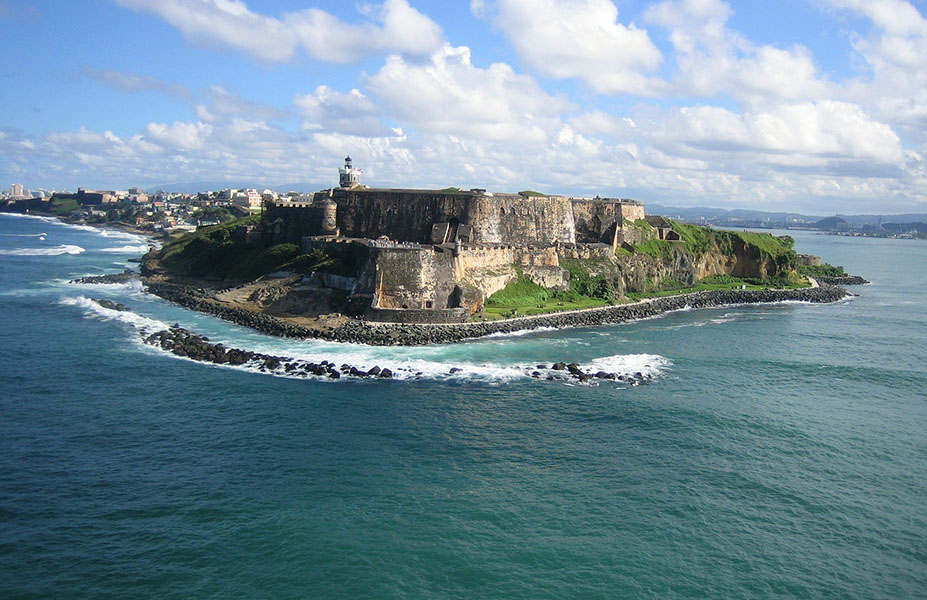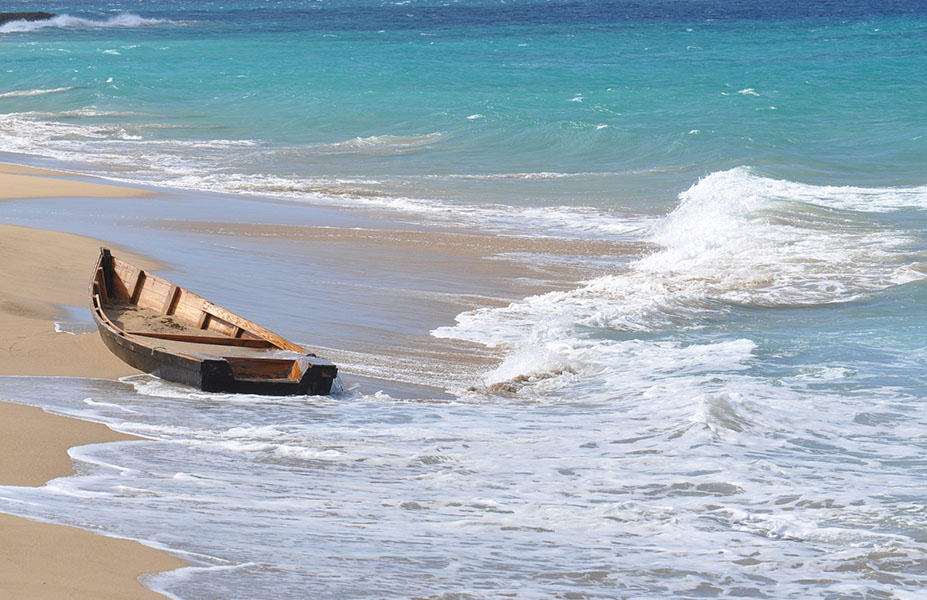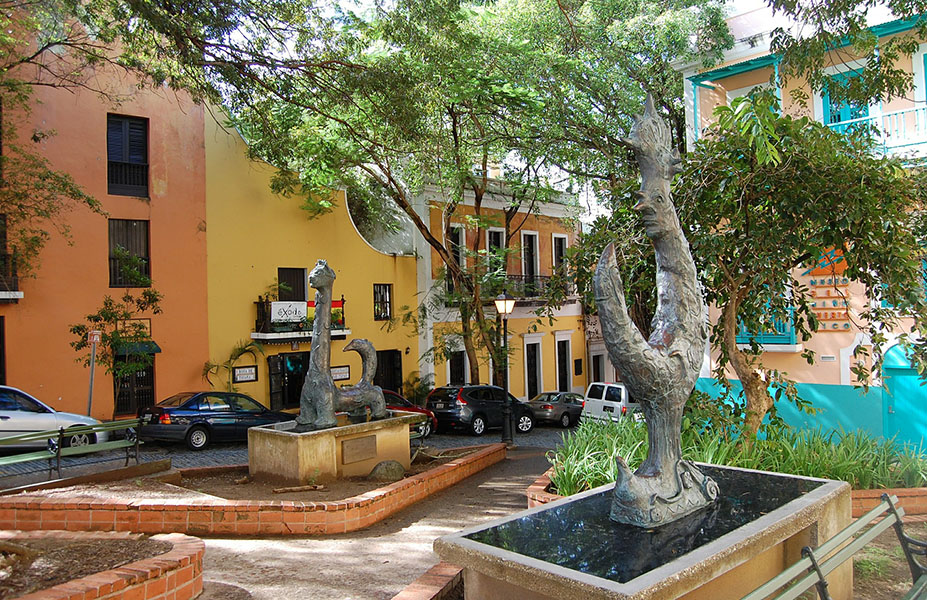Don’t miss next deals! Sign up for email alerts. Subscribe to #southamerica alerts »
Currency – United States dollar (US$)
Language – Spanish, English
Vaccine – none
Electricity – 120V. 60 Hz. Power plugs and sockets are of type A & B
EMERGENCY TELEPHONES
National Police: 911
Medical emergency: 911
The smallest of the Greater Antilles, Puerto Rico is situated east of the Dominican Republic. From the arrival of Columbus in 1493 to 1898, it was a Spanish colony whose inhabitants became US citizens in 1917.
However, this island known as «the island of enchantment» lives up to its nickname and offers the traveler who wants to learn more about it endless possibilities: colonial cities where visitors can learn about the country’s past and history since the arrival of the Spanish, world-class beaches, adventure sports, and natural parks with great ecological diversity. You’ll find all the details you need in this travel guide to Puerto Rico, so all you have to do now is pick a date to visit this tiny but charming island.
TOURIST SITES OF PUERTO RICO
Ponce – The jewel of the south. Along with the Caribbean, the old colonial palaces are slowly regaining their former glory.
San Juan of Puerto Rico – The country’s capital can boast of having one of the best preserved and renovated old quarters in the country. The city’s main draw is its colorful buildings, as well as its forts and walls.
Arecibo – Despite having many colonial buildings and a peculiar area full of unusual graffiti, this city on Puerto Rico’s north coast is not quite touristy.
Flamenco beach – It is said to be one of the best sandy areas in the country, and to see it, you must travel to Isla Culebra.
Luquillo – It is the most beautiful of Puerto Rico’s northern beaches. It features a large sandy area shaded by palm trees, a variety of hammocks where you can relax.
Palomino Island – While part of the beach belongs to the Hotel El Conquistador, if you have a boat, you can also get to the island and enjoy its white sand and clear waters.
Maria beach – This beach is very popular with surfers on the country’s west coast.
Boquerón Beach – This beach is considered one of the best in the west, with golden sand and palm trees that extend almost to the water’s edge.
Caja de Muertos Island – It can be reached by boat from Ponce and represents a Caribbean beach on an uninhabited island.
El Yunque Rain Forest – This forest, located in the Sierra de Luquillo, is ideal for walking along rivers and waterfalls while moving through four separate forest ecosystems
Caverns of the river Camuy – The caverns created by the Camuy River, one of the world’s longest underground rivers, are located just off Puerto Rico’s north coast.
Toro Negro State Forest – This forest, similar to El Yunque but with fewer tourists, offers the opportunity to hike along different routes, enjoy mountain views, and even bathe in one of its cool streams.
Bioluminescent bays – Traveling to Puerto Rico allows you to see the incredible bioluminescent bays, which are locations where microorganisms called dinoflagellates emit light and illuminate anything they come into contact with. The areas where you can see this phenomenon are La Parguera, Laguna Grande, and Isla de Vieques.
DAILY LIFE
They are pleasant, courteous, and great people. When confronted with a traveler’s query or need, everyone seems eager to assist, either by offering their “mobile phone” or accompanying, if possible, to the location sought. Their typical gesture is a smile, and they love going out into nature or taking walks by the sea.
Most Puerto Ricans are honest and approachable; they have no qualms about dancing salsa in any square in Old San Juan or approaching someone to compliment you on your dress or give you the same free juice they are offering to others.
They are quiet, and they walk slowly, which is something that irritates us when restaurants take longer than usual to get the dishes to the table.
The average Puerto Rican has a good standard of living, and the annual income rate is the highest in Latin America.
IN BARS AND RESTAURANTS
In general, eating in this country is not cheap, a meal for two in a mid-range restaurant, with a first to share, two main courses and two beers cannot be made for less than $45. Having a beer will cost around $5 if it is national, and enjoying a good piña colada means leaving $8.
TIPS
Generally, you tip in Puerto Rico as you would on the US mainland.
Bars $1 per drink. Luggage attendants $1-$2 per bag for anyone who helps with your luggage.
Restaurants 15% of the bill.Taxis 15% of the fare.
RELIGION
Catholic (85%), Protestants (8%), non religious (2.3%), and others (3%).
HOLIDAYS
January 1 New Years Day.
January 6 Three Kings Day.
January 11 Eugenio M. de Hostos Day.
January 18 Martin Luther King Jr.Day
February 17 George Washington Day.
March 22 Abolition Day.
April 16 José de Diego Day.
May 9 Mother’s Day.
May 31 Remembrance Day.
June 20 Father’s Day.
June 24 Day of Saint John the Baptist.
4th of July Independence Day.
July 17 Luís Muñoz Rivera Day.
July 25 Constitution Day.
July 27 José Celso Barbosa Day.
September 6 Labor Day.
October 11 Columbus Day.
November 11 Veteran’s Day.
November 19 Discovery of Puerto Rico.
November 25 Thanksgiving.
December 25 Christmas.
CLIMATE
The climate in Puerto Rico is tropical, warm throughout the year and with its corresponding rainy season.
In Puerto Rico it rains practically every day, in many cases everything will be a downpour that can last a few minutes and then again give way to the sun. The north of the island is rainier than the south, in cities like Ponce, next to the Caribbean, it is hotter and they can go months without receiving a drop of water.
The most propitious months to travel to Puerto Rico and enjoy good weather are between November and March, as temperatures are milder.
Between May and October is the rainy season and those famous hurricanes that cross the Caribbean every year. Temperatures vary during the year between 25º and 30º, although in the summer months there is also a high humidity index.
The gastronomic offer in Puerto Rico is varied, in cities like San Juan there are so many places that the difficult thing can be deciding which one to go to. In beach areas like Luquillo what you can find are chinchorros, simple restaurants near the sea where you can eat or drink. There are also American fast food chains and supermarkets where you can buy typical products or a few beers to drink on the beach.
TYPICAL DISHES
Mofongo:It’s made with fried bananas that have been crushed and then stuffed with seafood, meat, or fish.
Rice with beans: It is one of the most popular dishes in the country, and it is frequently served as a side dish to a main course.
Onion steak: It doesn’t have much of a secret, it’s a steak served with onion.
Lechón: The roast suckling pig is a favorite of Puerto Ricans, and it is popular for them to gather on weekends to eat it.
Tostones: Green plantain slices that have been mashed and fried. It’s called “yellows” if it’s made with yellow bananas, which are sweeter.
Sanchocho: Soup with chicken and vegetables.
Charcoal skewers: They are mostly found in beach hammocks and are made of beef, chicken, or pork.
Kan Kan chop: These are pork chops that haven’t had their skin removed and have been sliced into a curly pattern before being fried. They’re then accompanied by rice or salad.
Arepas: a type of cake made from ground corn that is opened and filled with beef, fish, or chicken after it has been baked.
BEVERAGES
Beer: there are many imported brands, but if you want to drink the country’s beer, you can drink Medalla or Magna.
Rum: white, old, smooth … there are so many types of rum that the difficult thing is to choose which one you prefer.
Piña colada: the country’s flagship cocktail was invented decades ago at the Barrachina restaurant in Old San Juan.
Coffee: it is produced in the country and is one of the quintessential beverages of Puerto Ricans, although many drink the typical watered-down American.
LOCAL FRUITS
Bananas, papayas, guavas, pineapples, coconuts, tamarind.
AIR TRANSPORT
In Puerto Rico, you can connect with an internal flight to reach another area of the island.
BOAT TRANSPORT
There are trips along the Amazon River, Sao Francisco River and through the Pantanal of Mato Grosso.
Cruises are organized that leave from Rio along the Brazilian coast that reach Buenos Aires in the south, and to the Caribbean in the north.
BUS TRANSPORT
Most of the interurban transport is carried out by bus (approximately 97% of internal journeys). The buses that cover the main routes are every day more modern and comfortable. If you are going to travel on different routes, you may have to make long stops, some at night, to make connections. Remember that the distances are long and that the bus trip can take days.
RAILWAY TRANSPORT
The railway network is very limited. There is the possibility of traveling some train journeys, but they are mostly tourist attractions.
ROAD NETWORK
Highways in Puerto Rico are toll roads with electronic payment lanes whose purpose is to improve the flow on the highways. If you rent a car and you want to travel on highways, it is best to also hire the prepayment of tolls that covers all those that can be used every day.
DRIVING
Driving on the roads of Puerto Rico is simple, everything is well signposted and it is difficult to get lost.
RENTAL CARS (We recommend reserving us in advance):
The option of renting a car is one of those that must be taken into account, especially if the intention is to travel beyond San Juan.
RENT A CAR at San Juan international airport >>>
TAXIS
Taxis are probably the best way to get around the city, but it is easy for them to charge you more or take you around. These taxis are yellow. Radio taxis are somewhat more expensive, but safer and more comfortable. Due to inflation and constant price increases, not all taximeters show the correct rate. Drivers should have a list displayed so that passengers can calculate the new rate based on what the meter reads.
Don’t miss next deals! Sign up for email alerts. Subscribe to #southamerica alerts »








